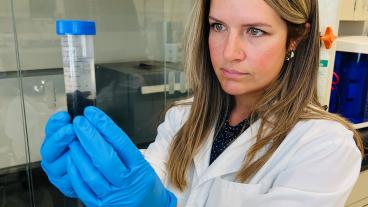Unsafe levels of polyfluoroalkyl and perfluoroalkyl substances, industrial chemicals linked to potentially serious health problems, have been found in the public drinking water of 33 states, according to a new study coauthored by Mines Civil and Environmental Engineering Associate Professor Chris Higgins.
The study, “Detection of Poly- and Perfluoroalkyl Substances (PFASs) in U.S. Drinking Water Linked to Industrial Sites, Military Fire Training Areas, and Wastewater Treatment Plants,” will be published August 9, 2016 in Environmental Science & Technology Letters. Higgins is one of twelve researchers contributing to the study, with Xindi C. Hu, from Harvard T. H. Chan School of Public Health, as the lead author.
The researchers looked at concentrations of six types of PFASs in drinking water supplies, using data from more than 36,000 water samples collected nationwide by the U.S. Environmental Protection Agency from 2013-2015.
They also looked at industrial sites that manufacture or use PFASs; at military fire training sites and civilian airports where fire-fighting foam containing PFASs is used; and at wastewater treatment plants. Discharges from these plants—which are unable to remove PFASs from wastewater by standard treatment methods—could contaminate groundwater. So could the sludge that the plants generate and which is frequently used as fertilizer.
Higgins, who has been researching the effects of PFASs for more than a decade, said, “Poly- and perfluoroaklyl acids are highly fluorinated synthetic organic chemicals that do not occur in nature. Their highly-fluorinated tails repel both oil and water, which is why they are used in so many consumer products. These compounds are used as stain repellents, paper packing products, and in making polymers like Teflon.”
The study found that PFASs were detectable at the minimum reporting levels required by the EPA in 194 out of 4,864 water supplies in 33 states across the U.S. Drinking water from 13 states accounted for 75% of the detections, including, in order of frequency of detection, California, New Jersey, North Carolina, Alabama, Florida, Pennsylvania, Ohio, New York, Georgia, Minnesota, Arizona, Massachusetts, and Illinois.
“It is a complex topic,” explained Higgins, “because these compounds stick around for a very long time in the environment and enter the environment in several ways. We are also exposed to them from a variety of sources.”
Higgins continued, “They are extremely difficult to remove from water. At Mines we are working on a variety of water treatment technologies to treat these compounds. A great deal of work remains to be done.”
Learn more about PFASs by watching our Facebook Live video of Associate Professor Chris Higgins explaining perfluoroalkyl substances and the implications of this new study.
Contact:
Deirdre Keating, Communications Manager, College of Engineering & Computational Sciences | 303-384-2358 | dkeating@mines.edu
Mark Ramirez, Communications Manager, College of Applied Science & Engineering | 303-384-2622 | ramirez@mines.edu



